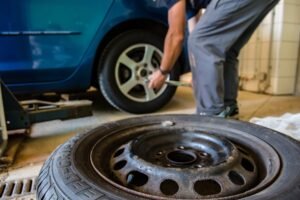You can worry less about getting involved in a car accident, particularly one that is tire pressure-related, because of your TPMS. When the warning light turns on, you know that you have to check your tires as one or more may be underinflated or overinflated. With this safety feature, you avoid tire blowouts which can be very dangerous, especially when you’re on a busy road.
While these systems are designed to provide accurate readings, they can malfunction or give false alerts. This means that the warning light turns on even when all the tires are properly inflated. Some car owners find these false alerts inconvenient and annoying, causing them to choose to disable their TPMS.
There are many reasons behind these inaccurate readings or warnings. Failing to do a TPMS relearn is the most common one.
TPMS Relearn – Not the Same as Sensor Programming
Many car owners do not know what a TPMS relearn is until they get charged for it at their dealership or car service centre. A TPMS relearn or reset is an electronic process wherein the new TPMS sensor is paired with the vehicle’s tire pressure monitoring system.
In case you didn’t know, the sensors or transponders are responsible for checking the pressure level in your tires. They send the data to your car’s ECU, which gives you a warning if a tire is underinflated or overinflated.
But for the sensors and TPMS to communicate, they need to be paired. To be more specific, the TPMS needs to know the unique IDs of the transponders. The system malfunctions or does not work at all when a reset or relearn is not done.
Take note:
A TPMS relearn is different from sensor programming.
The latter is all about configuring the transponders according to the specific MMY (make model year) of the vehicle. Doing this is necessary for some aftermarkets sensors as they come blank – not yet programmed to function with the vehicle’s TPMS.
Unlike sensor programming, TPMS relearn is mandatory for all vehicles after a tire or sensor replacement. This is because some aftermarket sensors are already pre-programmed to the vehicle’s specific MMY. If you use these transponders, you just have to install them and do a relearn after.
TPMS Relearn – How Is It Done?
A reset should be done each time you replace a sensor or tire. The TPMS relearn procedure varies per car manufacturer and model.
For some vehicles, the process is simple – just drive them to initiate and complete the relearn. An automatic relearn typically requires that the car be driven continuously for a duration of time and at a specified speed.
Meanwhile, other automobiles require the use of a scan tool and/or OBD module. This type of reset involves connecting to the vehicle’s computer and setting it to relearn mode.
Some vehicles require a stationary relearn. Here, a sequence of actions designated by the manufacturer needs to be done correctly to complete the relearn. This may include stepping on the brake, turning the key several times or combining other actions. The vehicle gives off an alert like blinking lights or a chirping horn if the process is successful.
Aside from the procedures mentioned above, specific steps and tools may be needed depending on the car’s make and model. For example, in some Honda vehicles, you have to lower your tire’s pressure level for at least a minute before re-inflating.
Suffice to say, each vehicle has a unique relearn procedure. Some are simple, but others can be complex. Hence, it is best to let professionals do it unless you are familiar with your car’s relearn process and have the essential tools.
But of course, choosing this option entails additional expenses. While a TPMS relearn does not cost much, you are bound to spend a significant amount of money in the long run, especially if you keep replacing your sensors or tires.
No longer want to spend on TPMS relearn or replacement sensors? Or are you simply tired of dealing with false TPMS warnings? Why not disable your TPMS using our bypass emulator? To learn more about our products, visit our website or call us today on UK: +44(0) 77 837 25020 or IRL: +353(0)83 847 8878.




0 Comments